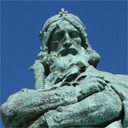0268 The Millennial Monument in Budapest as a Bearer of Memory, National Identity and Self-Awareness
Identifiers (Article)
Abstract
In the 19th century, one of the most important national events in Hungary was the 1896 millennial celebration of the Hungarian conquest of the Carpathian Basin. A central act of the festivity’s symbolical episodes was the erection of the so-called Millennium Memorial (or Millennial Monument) at Heroes’ Square in Budapest. The monument consists of a colonnaded architectural framework that embraces a sculpture gallery featuring Hungarian leaders and rulers. My paper presents the history of the monument from concept to completion. Besides the artistic patterns of the architectural framework designed by Albert Schickedanz, special attention is given to the sculptures of the Hungarian sculptors who worked under the direction of the artist György Zala, as well as to the relations between the sculptors and the artistic scene of Vienna, and to the models they used. In addition to these primarily art historical aspects, my paper discusses the cultural context of the Memorial. It seeks answers to the questions of how the Memorial became a symbol of national identity already at the stage of planning and what ideas about the shaping of the national self-image defined the final form of the Memorial.
Statistics


License

This work is licensed under a Creative Commons Attribution-NonCommercial-NoDerivatives 4.0 International License.



